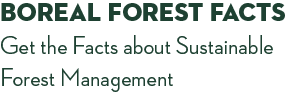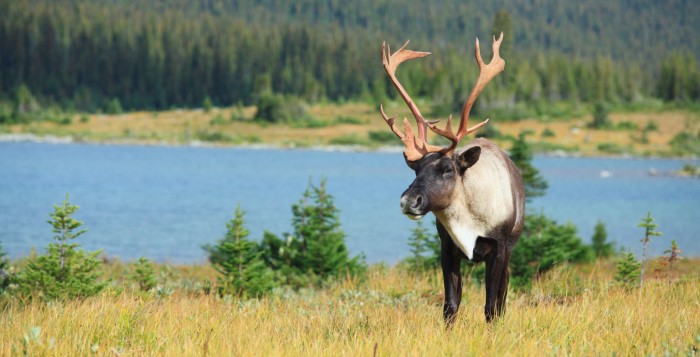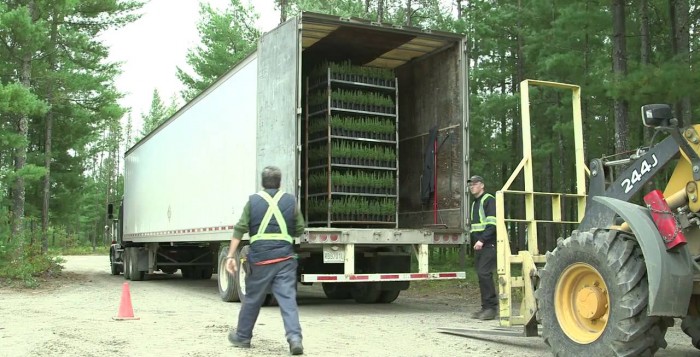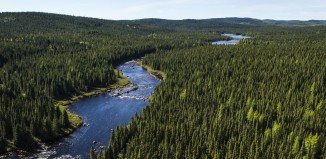Herbicides are an important tool for regenerating harvested forest areas. Glyphosate is the most commonly used herbicide in Canada, but misconceptions abound. Here, we answer some common questions about glyphosate.
Why do we use glyphosate?
In Canada, 100% of harvested areas must be reforested. Most harvested areas in Ontario and Quebec grow back naturally. Foresters ensure the rest is promptly regenerated – often through non-chemical methods, and where necessary, with the help of herbicides like glyphosate.
As much as possible, foresters aim to regenerate harvested areas with the same species that were present before the harvest. But at the early stage of the regeneration process, certain plant species, known as “pioneer” species, threaten to overtake the young spruce and pine saplings and hinder their growth in certain areas. Glyphosate is highly effective at controlling these competing species in order to reinstate the proper species cover.
No matter the method of regeneration in a given area, the process is closely monitored and highly regulated to ensure its success[1].
If some areas regenerate without herbicides, are they really necessary?
In areas that need help regenerating, the objective is to regenerate to a specific standard. Different areas see varying amounts of success depending on the method of control used. Mechanical control is often used for shrub vegetation, but is mostly ineffective against herbaceous competition. Many other methods have been tried, including laying down mulch mats, bringing in grazing livestock and even developing an indigenous fungus as a microbial biocontrol agent. But the fact is, no other method is as cost-effective, efficient or reliable as modern chemical herbicides[2].
And if competing vegetation is not controlled, some areas see reduced or even failed regeneration.
Is glyphosate safe?
Glyphosate has been mentioned in the news in recent months, and many people are understandably concerned about its effects. However, scientists and regulators maintain that glyphosate poses minimal risk to people and to our environment.
According to the Canadian Forestry Service:
“The potential effects of a herbicide on either humans or any wildlife species depends on the magnitude, duration, frequency and route of exposure. Just as there are levels of alcohol or caffeine that may be consumed without any noticeable or measurable effect, there are levels of exposure for wildlife or humans to herbicides for which we cannot observe or measure a direct or indirect deleterious effect.”
- Risk to public health: Glyphosate use is stringently regulated by Health Canada in order to avoid risk to public health. Herbicides containing glyphosate are some of the most thoroughly tested in the world, and decades of extensive toxicological studies have demonstrated that glyphosate does not cause cancer, birth defects, mutagenic effects, or allergic reactions when used as recommended. These are the conclusions reached by Health Canada as well as by the World Health Organization. Health Canada’s Pest Management and Regulatory Agency (PMRA) regularly reviews published studies and other risk assessments to determine the level of risk to the public.
The International Agency for Research on Cancer (IARC) of the World Health Organization (WHO) rated glyphosate as “probably carcinogenic to humans,” the same category (2A) they use to classify sunshine, aloe vera, cell phones, coffee and being a barber.
Health Canada addressed this announcement in their re-evaluation decision published on April 13, 2015:
The WHO’s International Agency for Research on Cancer (IARC) recently assigned a hazard classification for glyphosate as “probably carcinogenic to humans”. It is important to note that a hazard classification is not a health risk assessment. The level of human exposure, which determines the actual risk, was not taken into account by WHO (IARC). Pesticides are registered for use in Canada only if the level of exposure to Canadians does not cause any harmful effects, including cancer.
In its latest re-evaluation of the use of glyphosate-based herbicides, Health Canada concluded that “products containing glyphosate do not present unacceptable risks to human health or the environment when used according to the proposed label directions.”
- Risk to workers: Based on regulatory risk assessments conducted by the PMRA and several other international reviews, the use of glyphosate-based herbicides applied in accordance with the specific product labels does not pose a significant risk to either applicators or others who might be inadvertently exposed.
- Risk to the environment: Numerous field studies on this topic have been undertaken in Canadian forest ecosystems. What they found is perhaps best understood in terms of what glyphosate does NOT do:
- It does NOT linger in soil, vegetation or water, and it has a very low potential for leaching into ground water.
- It does NOT accumulate in animals, or poison birds, fish, aquatic invertebrates, small mammals, large mammals or amphibians.
- It does NOT kill all other plants to create a single-species forest plantation.
- And it does NOT cause a reduction in soil microbial populations or significantly impair their function. [3] In fact, some studies even recommend the use of this treatment to maintain the coniferous cover necessary to favor woodland caribou (a species at risk) over moose in some areas.[4]
Resolute will continue to monitor new developments and research regarding the safety of glyphosate.
How does glyphosate work?
The mode of action of glyphosate affects the production of certain amino acids, a metabolic process found only in plants and a few micro-organisms.
How are herbicides like glyphosate applied?
In Canada forests, herbicides are usually applied aerially. The areas scheduled for herbicide application average around 200 hectares per day and are typically very remote. Aerial application of these products is not only economical, it is better than sending crews in, which can be disruptive to an area that is regenerating. As for accuracy, technologically advanced systems are used to minimize risks of drift outside of the target areas. Legislative requirements and guidance systems ensure that water bodies next to aerially treated sites are protected by standing timber buffers. In Ontario, Resolute relies exclusively on helicopters, which increases the control over spray areas as compared to fixed wing planes and provides precision when working with smaller areas.
Areas are typically sprayed only once, usually during the first five years postharvest, either prior to or after planting seedlings. Spraying is only conducted where necessary, and only approved herbicides are applied by experienced and qualified experts.
Many different measures are taken to minimize the impact of herbicides, such as:
- Extensive training and licensing for professional aerial applicators
- Modern application technologies, such as low drift nozzles, electronic guidance systems, and the legislative requirement for buffer zones to protect aquatic ecosystems
Studies have demonstrated that toxicologically significant deposits of glyphosate are very unlikely to occur at any distance beyond ~ 30 to 50 meters from target zone boundaries, thus confirming the protective value of the 60 or 120 meter buffers imposed.
How much glyphosate is used in the woodlands managed by Resolute?
Resolute operates in Quebec and Ontario, two Canadian provinces with differing regulations and forest management practices.
In Ontario, about one third of harvested areas are treated with glyphosate – only when natural regeneration is not possible and non-chemical reforestation techniques have not been successful. This amounts to approximately 70,000 hectares each year, or 0.28% of the province’s total productive forestland.
In Quebec, a provincial ban on all chemical herbicide use in forests has been in effect since 2001. Consequences on the ability to maintain proper stocking in coniferous plantations has been reported. A study conducted in 2015 by Quebec’s Chief Forester’s Office showed that in some areas, more than half of replanted areas did not reach required stocking levels after a few years of competition[3].
The quantity of glyphosate typically used in Canadian forestry is 0.7-2.16 kilograms per hectare. In comparison, risk to bird growth is observed at 6.2 kilograms per hectare, and risk to terrestrial mammal growth and reproduction is observed at 9 kilograms per hectare for a small mammal, like a mouse. Canadian foresters use significantly lower doses than what would pose even a low risk to wildlife[4].
As opposed to agriculture or urban landscape management where herbicides are used on a regular basis, glyphosate may only need to be used once or twice over the lifetime of a forest stand (only in its early stages).
Why are herbicides banned in Quebec?
Decisions to ban pesticides are not necessarily based solely on science. Bans occur in some jurisdictions and not others even though the same scientific information is available to all. While Quebec has chosen to ban the use of all chemical pesticides in forestry (including for insect control), most other Canadian provinces including Ontario, British Columbia, and New Brunswick use herbicides (particularly glyphosate) to ensure effective and efficient regeneration, which in turn contributes to overall sustainable forest management.
Sustainable forest management means producing forested conditions that support timber and non-timber values for the future. Herbicides are one tool in the forester’s toolbox to achieve this goal.
[1] Natural Resources Canada. Boreal Forest. https://www.nrcan.gc.ca/forests/boreal/13071
[2] Canadian Forestry Service. Frequently Asked Questions on the use of Herbicides in Canadian Forestry. http://cfs.nrcan.gc.ca/pubwarehouse/pdfs/32344.pdf
[3] Bureau du forestier en chef. 2015. Succès des plantations. Avis du Forestier en chef. FEC-AVIS-04-2015, Roberval, Québec, 22 p. + annexes. http://forestierenchef.gouv.qc.ca/wp-content/uploads/2015/12/fec-avis-04-2015.pdf
[4] Canadian Forestry Service webinar
Addressing the conservation of woodland caribou in Canada: A work in progress
Woodland caribou is an emblematic species of the boreal forest. It is such a national symbol in Canada that it is featured on the 25 cents piece and has been for decades. Due to the observed decline of populations of woodland caribou over several years of monitoring in several regions in Canada, the species was added to the Canadian government’s list of threatened species in 2002 . Since that time, the country’s provinces, First Nations, communities and the forest products industry have collaborated to take action for the long-term recovery and survival of this noble creature.
Three quarters of the caribou’s territory has already been safeguarded
- In Quebec, 76 percent of the caribou’s range is off limits to harvesting
- In Ontario, 77 percent of the caribou’s range is off limits to harvesting
Caribou, Predators and Habitat Change
Caribou protect themselves from predators, such as wolves, coyotes and bears, by spreading out over large areas of land. While you might find two to three moose per square kilometer (250 acres) in the boreal, you’ll generally find just one to two caribou per tract of 100 square kilometers (25,000 acres).
This strategy of spreading the population over vast regions makes it much less likely that a caribou will encounter a predator, which allows the species to grow and propagate without having to constantly be on the lookout to avoid or escape being hunted. In many cases, caribou fall victim to wolves, coyotes and bears who are actually hunting for bigger game, like moose. Woodland caribou, unlike their tundra dwelling relatives, don’t assemble in large herds that make it easy for wolves to hunt. In addition, because of their smaller size, compared to moose, they don’t offer as much of a meal when they do happen to be caught.
When tracts of forest are harvested, low vegetation, herbs and new trees quickly colonize the fertile and newly open area. This type of ground cover provides a rich and abundant source of forage, which attracts several herbivores species, such as moose. As a consequence of the influx of moose, wolves, coyotes and bears also find their way to the area in order to hunt. As the number of predators increases, the likelihood of one of them running into a caribou also goes up, which eventually leads to reduced caribou populations.
Resolute protects land to increase caribou habitat
In order to ensure that caribou habitat remains safe and abundant well into the future, Resolute is promoting forest management practices that target large tracts of land while leaving sufficient forested areas to meet the caribou’s habitat requirements. The areas identified for caribou conservation must be large enough to allow caribou to rely on their dispersion strategy to reduce encounters with predators. In addition to this approach, we have also supported several initiatives to set aside additional territory, some of which are currently under discussion as part of the Canadian Boreal Forest Agreement (CBFA).
Up to now, Resolute has made the following contributions in land toward the conservation of woodland caribou habitat:
- In Northeastern Ontario, the Company, along with CBFA partners, supports a proposal for an additional caribou conservation area covering almost 8,348 square kilometres on the Abitibi River Forest (3,223 square miles).
- In Northwestern Ontario, predecessor companies of Resolute Forest Products contributed some of their tenure lands for the creation of Wabakimi Provincial Park, which covers an area of 8,920 square kilometers, and is one of the largest parks in the province.
- In Quebec, Resolute was among the first companies to propose and implement an action plan for caribou. The Company also contributed to the government process to identify protected areas suitable for caribou protection.
Safeguarding caribou with sound management
With over 75% of the caribou range located north of the managed forest, we rely on numerous strategies, best practices and guidelines developed specifically for caribou conservation to provide suitable habitat for woodland caribou within the 25% of the range that falls in the managed forest. Ontario’s Caribou Conservation Plan is one example of a government guideline supporting caribou sustainability. These strategies, which are built into our forest management plans, focus on providing habitat for caribou across the landscape on a long-term basis, and minimizing disturbances to caribou populations by using the following guidelines:
- The development of road management strategies in each forest management plan identifies the location of roads, building techniques and closing procedures with caribou conservation in mind.
- Areas that are important to caribou, such as caribou calving lakes, are prioritized for protection.
- Conifer regeneration, which will result in suitable caribou habitat in the future, is prioritized in accordance with habitat protection decisions.
- Harvest operations across the landscape are scheduled over time, in order to minimize overall disturbance levels for caribou populations.
The 150-Year Plan
Perhaps the most widespread approach to harvesting, is known as a “dynamic caribou habitat scheduling,” where areas in which an optimal harvesting sequence can be carried out over a span of 100 to 150 years are identified, so that suitable caribou habitat is constantly maintained in a caribou population range. By applying this technique, large areas of suitable habitat are continuously maintained for caribou across the landscape. These caribou “deferrals” move over in the region where and when previously harvested areas have acquired the desirable caribou habitat attributes. It is only when the caribou have other areas in which to safely move, that those previously deferred areas can be harvested. This approach concentrates harvest operations in defined areas, in order to minimize disturbance levels at any given time for caribou populations across the broader range of the species.
Looking Forward
Resolute has clearly expressed its commitment to sustaining woodland caribou populations with a combination of sustainable forest management practices, conservation of caribou habitat and the application of dynamic habitat scheduling in harvested areas to minimize disturbance and maintain sufficient caribou habitat across the landscape. Our company will continue to prioritize the conservation of this noble creature and national symbol well into the future, while also seeking additional partners and innovative approaches to further benefit woodland caribou populations across Canada.
At Resolute Forest Products we want to have an open and honest discussion about the Canadian boreal forest and sustainable forest management. We welcome the opportunity to answer any questions you have. We created this page to field your questions, provide our responses, and have that discussion.
We also posted frequently asked questions with answers below. If you can’t find what you’re looking for, then we invite you to ask your question at the bottom of the page and we’ll do our best to respond quickly.
1) What is the Canadian Boreal Forest Agreement?
Signed in 2010, the Canadian Boreal Forest Agreement (CBFA) is the world’s largest conservation agreement, originally bringing together 21 member companies of the Forest Products Association of Canada (FPAC) and nine environmental organizations to achieve the joint goal of ensuring the sustainability of the Canadian boreal forest for generations to come.
Resolute helped found the CBFA because of our commitment to sustainable forest management.
Read more about the CBFA and our involvement here.
2) How do you care for the Canadian boreal forest?
Resolute Forest Products practices forest stewardship to ensure the sustainability of the natural resources in our care. Stewardship means choosing carefully where to harvest, adopting nature’s methods, and ensuring regeneration. We take a multi-pronged approach to forest stewardship.
First, we develop comprehensive plans with regards to where we harvest. In Canada, we work on public lands, and only a portion of the boreal is open to harvesting. The boreal forest is one of the world’s most carefully managed forests, and we make sure to comply with all of the stringent regulations that govern it.
This involves:
- Picking the right spot: Drawing on hundreds of maps, comprehensive wildlife surveys and decades of data, we block off areas where harvesting might conflict with traditional activities of First Nations (Native Canadians), consider the impact on wildlife habitat and take into account the area’s topographical features (for example, proximity to a river).
- Mimicking nature’s method: We emulate natural disturbances in order to optimize forest regeneration.
- Harvesting only certain trees: In the boreal, Resolute primarily works with softwood species such as black spruce, white spruce, jack pine and balsam fir. We also work with some hardwood species such as white birch and poplar. All these species require little to no help to regenerate quickly and abundantly. One exception is jack pine, which requires high temperatures (such as in the case of a forest fire) for its cones to release seeds.
Learn more about our forest management practices.
3) What have you done to protect caribou?
First, Resolute has supported proposals to set aside additional territory to safeguard caribou, specifically:
- In Northeastern Ontario, an area in which Resolute receives 57 percent of the wood allocation, the Company, along with CBFA partners, supports a proposal for an additional caribou conservation area covering almost 3,223 square miles (835,000 hectares).
- In Northwestern Ontario, Resolute has proposed setting aside an additional 787 square miles (204,000 hectares) of forest.
- In Quebec, Resolute proposed an additional 2,671 square miles (692,000 hectares).
In addition to setting aside land, within the caribou range where harvesting is permitted, numerous techniques, best practices and guidelines are used to ensure prompt renewal of the forest, to emulate patterns of natural disturbance, and to ensure minimal disruption to wildlife, and especially the unique needs of caribou. These techniques govern:
- The location of roads and how they are built
- Distances between bodies of water and roads
- Distances between bodies of water and the blocks designated for harvesting wood
- Methodology for building bridges and tunnels to ensure minimum disruption
Learn more about how Resolute safeguards caribou.
Care to discuss the issues? We want to hear from you.
Resolute Forest Products created Boreal Forest Facts to give everyone a place to discuss the sustainable management of our natural resources. We drafted the following rules to foster and protect open, honest, and respectful dialogue.
Rules on Commenting
Be civil and respectful: We reserve the right to delete posts that contain offensive or hurtful language and will not tolerate personal insults.
Check your facts: We reserve the right to correct incorrect statements or information taken out of context.
Stay on topic: We reserve the right to delete off-topic posts and unrelated links.
Don’t advertise: All spam and ads will be deleted.
Post your own thoughts: We reserve the right to delete posts that are in violation of another person’s intellectual property or copyright.
Don’t imitate other people: We reserve the right to remove content attempting to impersonate someone else including, but not limited to customers, clients, Resolute employees or other community members.







